The UK's Transparency Act: Combating Child Labour in Supply Chains
VerifiedAdded on 2023/06/18
|6
|1470
|274
Essay
AI Summary
This essay provides an overview of child labour issues with a focus on the UK supply chain. It discusses the prevalence of child labour, particularly in agriculture, and its impact on children's physical, mental, and emotional well-being. The essay analyzes the UK's Business Supply Chain Transparency on Slavery and Trafficking Act of 2018, examining its effectiveness in addressing child labour. It also explores arguments both for and against child labour, considering factors such as poverty, cultural beliefs, and access to education. The essay concludes by emphasizing the importance of a multidisciplinary approach and equal access to education in combating child labour and highlights the role of supply chain transparency in identifying and addressing the issue.
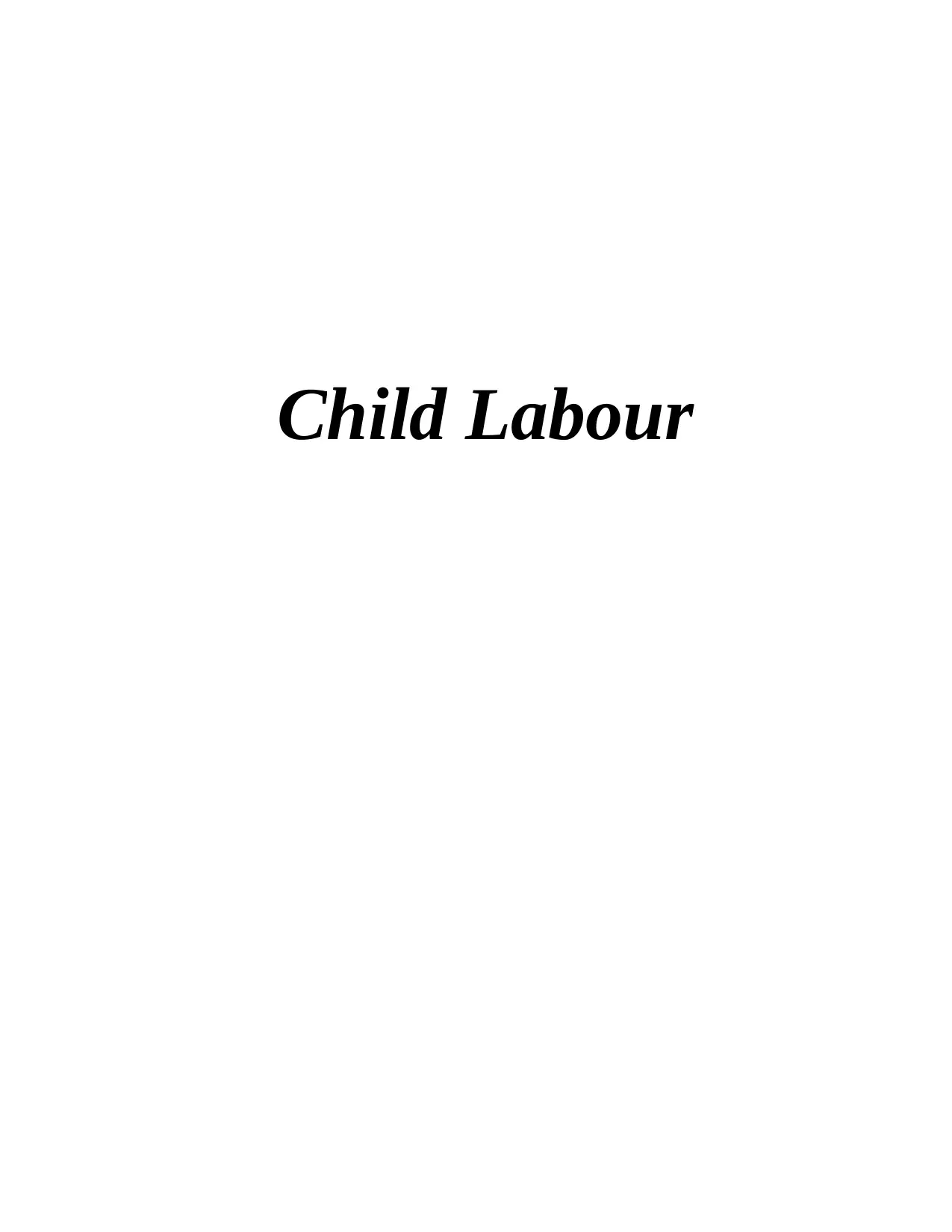
Child Labour
Paraphrase This Document
Need a fresh take? Get an instant paraphrase of this document with our AI Paraphraser
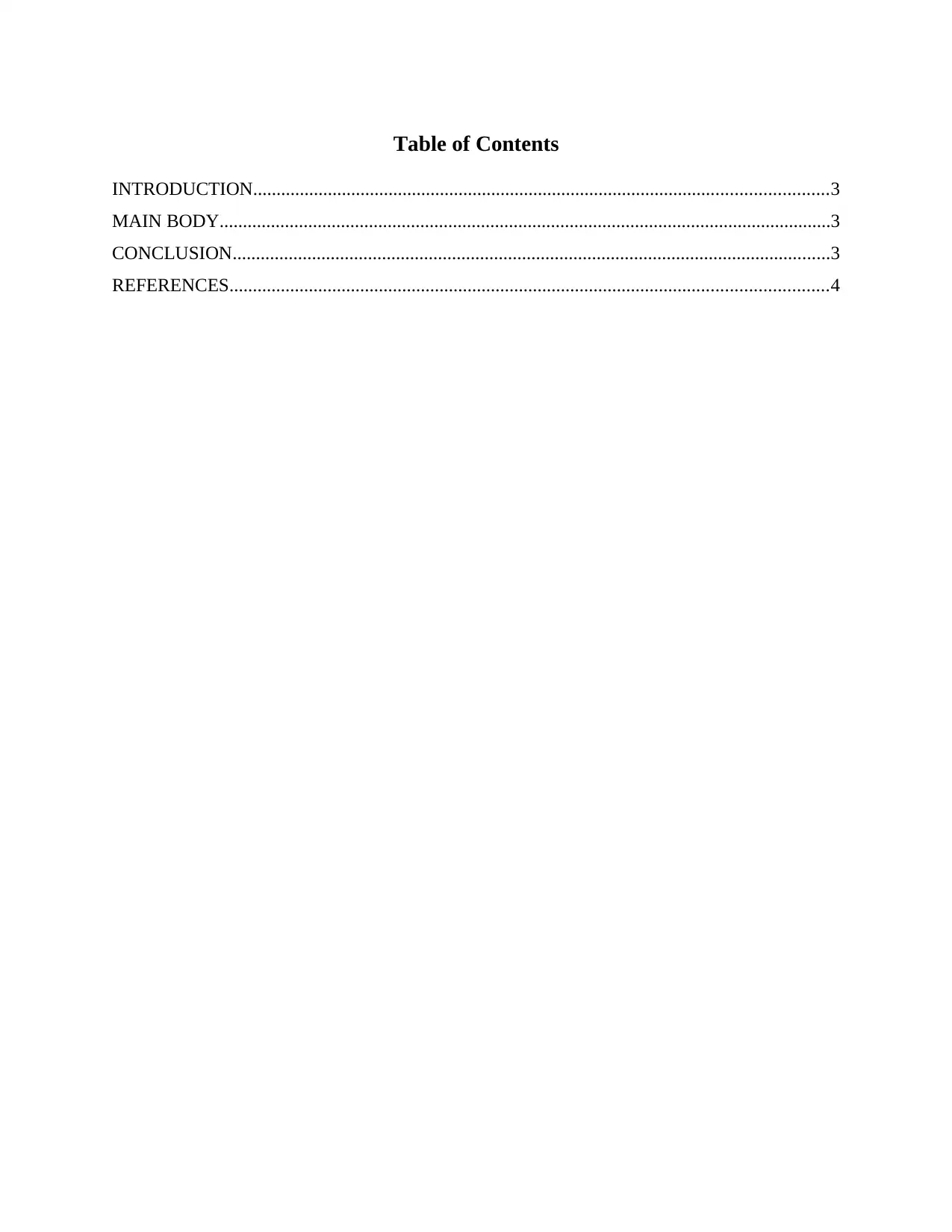
Table of Contents
INTRODUCTION...........................................................................................................................3
MAIN BODY...................................................................................................................................3
CONCLUSION................................................................................................................................3
REFERENCES................................................................................................................................4
INTRODUCTION...........................................................................................................................3
MAIN BODY...................................................................................................................................3
CONCLUSION................................................................................................................................3
REFERENCES................................................................................................................................4
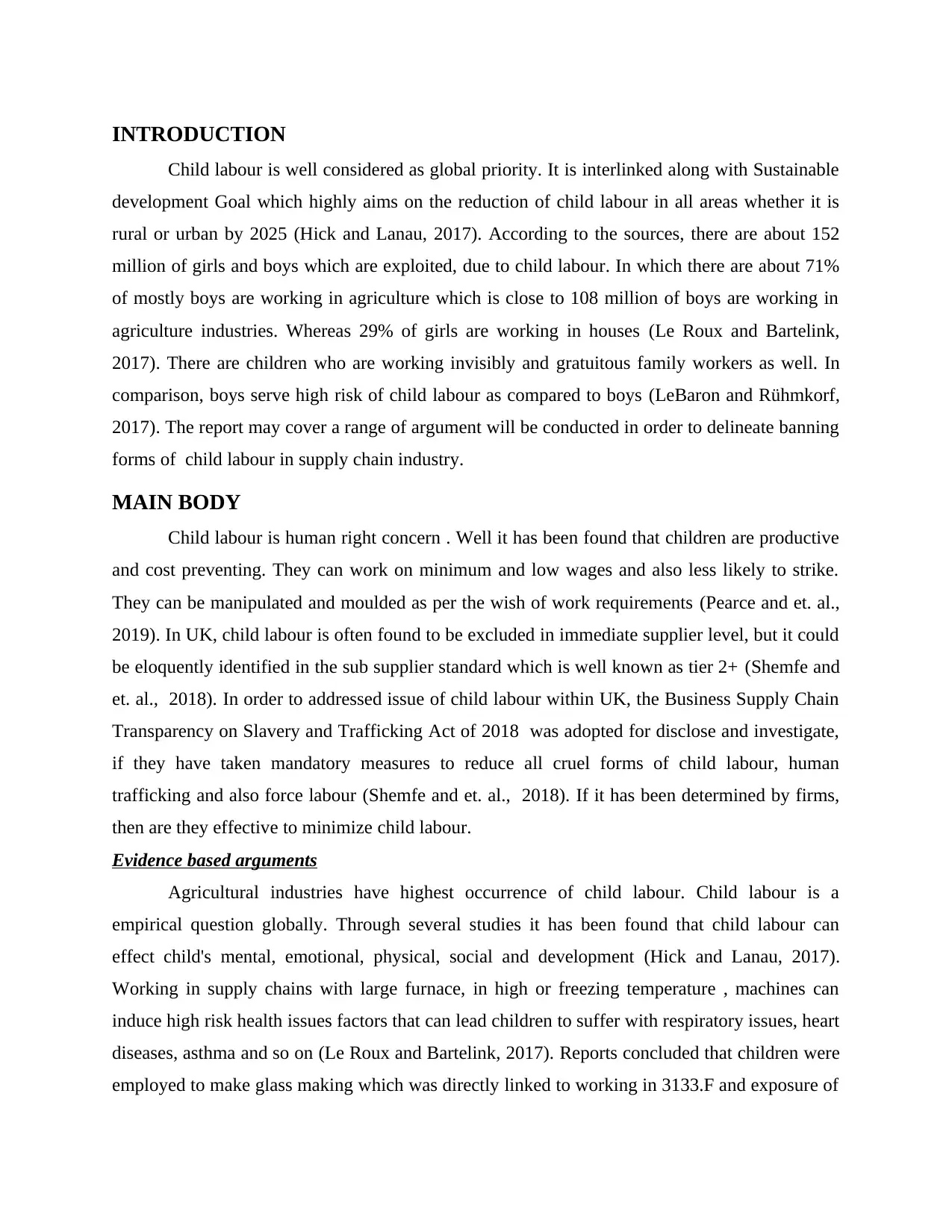
INTRODUCTION
Child labour is well considered as global priority. It is interlinked along with Sustainable
development Goal which highly aims on the reduction of child labour in all areas whether it is
rural or urban by 2025 (Hick and Lanau, 2017). According to the sources, there are about 152
million of girls and boys which are exploited, due to child labour. In which there are about 71%
of mostly boys are working in agriculture which is close to 108 million of boys are working in
agriculture industries. Whereas 29% of girls are working in houses (Le Roux and Bartelink,
2017). There are children who are working invisibly and gratuitous family workers as well. In
comparison, boys serve high risk of child labour as compared to boys (LeBaron and Rühmkorf,
2017). The report may cover a range of argument will be conducted in order to delineate banning
forms of child labour in supply chain industry.
MAIN BODY
Child labour is human right concern . Well it has been found that children are productive
and cost preventing. They can work on minimum and low wages and also less likely to strike.
They can be manipulated and moulded as per the wish of work requirements (Pearce and et. al.,
2019). In UK, child labour is often found to be excluded in immediate supplier level, but it could
be eloquently identified in the sub supplier standard which is well known as tier 2+ (Shemfe and
et. al., 2018). In order to addressed issue of child labour within UK, the Business Supply Chain
Transparency on Slavery and Trafficking Act of 2018 was adopted for disclose and investigate,
if they have taken mandatory measures to reduce all cruel forms of child labour, human
trafficking and also force labour (Shemfe and et. al., 2018). If it has been determined by firms,
then are they effective to minimize child labour.
Evidence based arguments
Agricultural industries have highest occurrence of child labour. Child labour is a
empirical question globally. Through several studies it has been found that child labour can
effect child's mental, emotional, physical, social and development (Hick and Lanau, 2017).
Working in supply chains with large furnace, in high or freezing temperature , machines can
induce high risk health issues factors that can lead children to suffer with respiratory issues, heart
diseases, asthma and so on (Le Roux and Bartelink, 2017). Reports concluded that children were
employed to make glass making which was directly linked to working in 3133.F and exposure of
Child labour is well considered as global priority. It is interlinked along with Sustainable
development Goal which highly aims on the reduction of child labour in all areas whether it is
rural or urban by 2025 (Hick and Lanau, 2017). According to the sources, there are about 152
million of girls and boys which are exploited, due to child labour. In which there are about 71%
of mostly boys are working in agriculture which is close to 108 million of boys are working in
agriculture industries. Whereas 29% of girls are working in houses (Le Roux and Bartelink,
2017). There are children who are working invisibly and gratuitous family workers as well. In
comparison, boys serve high risk of child labour as compared to boys (LeBaron and Rühmkorf,
2017). The report may cover a range of argument will be conducted in order to delineate banning
forms of child labour in supply chain industry.
MAIN BODY
Child labour is human right concern . Well it has been found that children are productive
and cost preventing. They can work on minimum and low wages and also less likely to strike.
They can be manipulated and moulded as per the wish of work requirements (Pearce and et. al.,
2019). In UK, child labour is often found to be excluded in immediate supplier level, but it could
be eloquently identified in the sub supplier standard which is well known as tier 2+ (Shemfe and
et. al., 2018). In order to addressed issue of child labour within UK, the Business Supply Chain
Transparency on Slavery and Trafficking Act of 2018 was adopted for disclose and investigate,
if they have taken mandatory measures to reduce all cruel forms of child labour, human
trafficking and also force labour (Shemfe and et. al., 2018). If it has been determined by firms,
then are they effective to minimize child labour.
Evidence based arguments
Agricultural industries have highest occurrence of child labour. Child labour is a
empirical question globally. Through several studies it has been found that child labour can
effect child's mental, emotional, physical, social and development (Hick and Lanau, 2017).
Working in supply chains with large furnace, in high or freezing temperature , machines can
induce high risk health issues factors that can lead children to suffer with respiratory issues, heart
diseases, asthma and so on (Le Roux and Bartelink, 2017). Reports concluded that children were
employed to make glass making which was directly linked to working in 3133.F and exposure of
⊘ This is a preview!⊘
Do you want full access?
Subscribe today to unlock all pages.

Trusted by 1+ million students worldwide
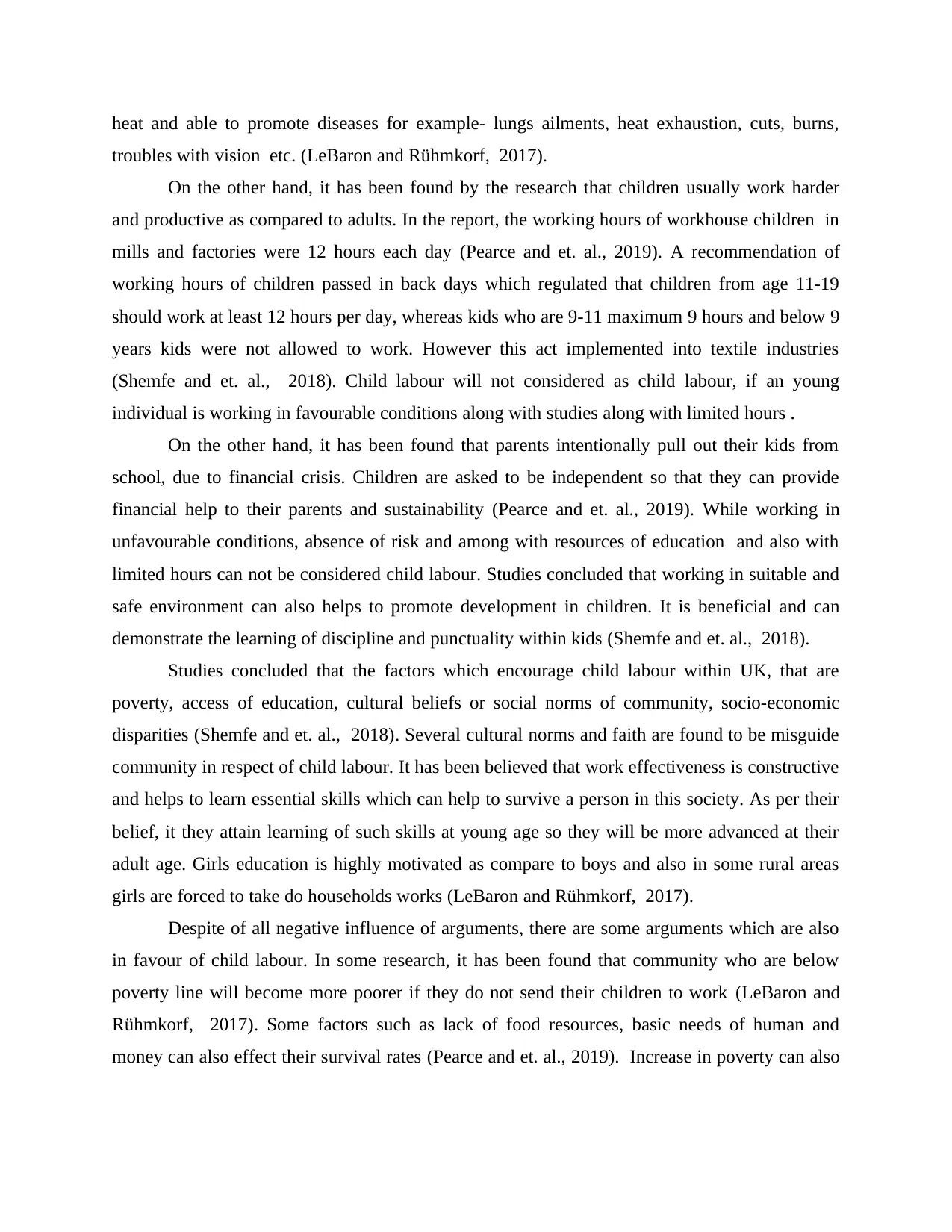
heat and able to promote diseases for example- lungs ailments, heat exhaustion, cuts, burns,
troubles with vision etc. (LeBaron and Rühmkorf, 2017).
On the other hand, it has been found by the research that children usually work harder
and productive as compared to adults. In the report, the working hours of workhouse children in
mills and factories were 12 hours each day (Pearce and et. al., 2019). A recommendation of
working hours of children passed in back days which regulated that children from age 11-19
should work at least 12 hours per day, whereas kids who are 9-11 maximum 9 hours and below 9
years kids were not allowed to work. However this act implemented into textile industries
(Shemfe and et. al., 2018). Child labour will not considered as child labour, if an young
individual is working in favourable conditions along with studies along with limited hours .
On the other hand, it has been found that parents intentionally pull out their kids from
school, due to financial crisis. Children are asked to be independent so that they can provide
financial help to their parents and sustainability (Pearce and et. al., 2019). While working in
unfavourable conditions, absence of risk and among with resources of education and also with
limited hours can not be considered child labour. Studies concluded that working in suitable and
safe environment can also helps to promote development in children. It is beneficial and can
demonstrate the learning of discipline and punctuality within kids (Shemfe and et. al., 2018).
Studies concluded that the factors which encourage child labour within UK, that are
poverty, access of education, cultural beliefs or social norms of community, socio-economic
disparities (Shemfe and et. al., 2018). Several cultural norms and faith are found to be misguide
community in respect of child labour. It has been believed that work effectiveness is constructive
and helps to learn essential skills which can help to survive a person in this society. As per their
belief, it they attain learning of such skills at young age so they will be more advanced at their
adult age. Girls education is highly motivated as compare to boys and also in some rural areas
girls are forced to take do households works (LeBaron and Rühmkorf, 2017).
Despite of all negative influence of arguments, there are some arguments which are also
in favour of child labour. In some research, it has been found that community who are below
poverty line will become more poorer if they do not send their children to work (LeBaron and
Rühmkorf, 2017). Some factors such as lack of food resources, basic needs of human and
money can also effect their survival rates (Pearce and et. al., 2019). Increase in poverty can also
troubles with vision etc. (LeBaron and Rühmkorf, 2017).
On the other hand, it has been found by the research that children usually work harder
and productive as compared to adults. In the report, the working hours of workhouse children in
mills and factories were 12 hours each day (Pearce and et. al., 2019). A recommendation of
working hours of children passed in back days which regulated that children from age 11-19
should work at least 12 hours per day, whereas kids who are 9-11 maximum 9 hours and below 9
years kids were not allowed to work. However this act implemented into textile industries
(Shemfe and et. al., 2018). Child labour will not considered as child labour, if an young
individual is working in favourable conditions along with studies along with limited hours .
On the other hand, it has been found that parents intentionally pull out their kids from
school, due to financial crisis. Children are asked to be independent so that they can provide
financial help to their parents and sustainability (Pearce and et. al., 2019). While working in
unfavourable conditions, absence of risk and among with resources of education and also with
limited hours can not be considered child labour. Studies concluded that working in suitable and
safe environment can also helps to promote development in children. It is beneficial and can
demonstrate the learning of discipline and punctuality within kids (Shemfe and et. al., 2018).
Studies concluded that the factors which encourage child labour within UK, that are
poverty, access of education, cultural beliefs or social norms of community, socio-economic
disparities (Shemfe and et. al., 2018). Several cultural norms and faith are found to be misguide
community in respect of child labour. It has been believed that work effectiveness is constructive
and helps to learn essential skills which can help to survive a person in this society. As per their
belief, it they attain learning of such skills at young age so they will be more advanced at their
adult age. Girls education is highly motivated as compare to boys and also in some rural areas
girls are forced to take do households works (LeBaron and Rühmkorf, 2017).
Despite of all negative influence of arguments, there are some arguments which are also
in favour of child labour. In some research, it has been found that community who are below
poverty line will become more poorer if they do not send their children to work (LeBaron and
Rühmkorf, 2017). Some factors such as lack of food resources, basic needs of human and
money can also effect their survival rates (Pearce and et. al., 2019). Increase in poverty can also
Paraphrase This Document
Need a fresh take? Get an instant paraphrase of this document with our AI Paraphraser
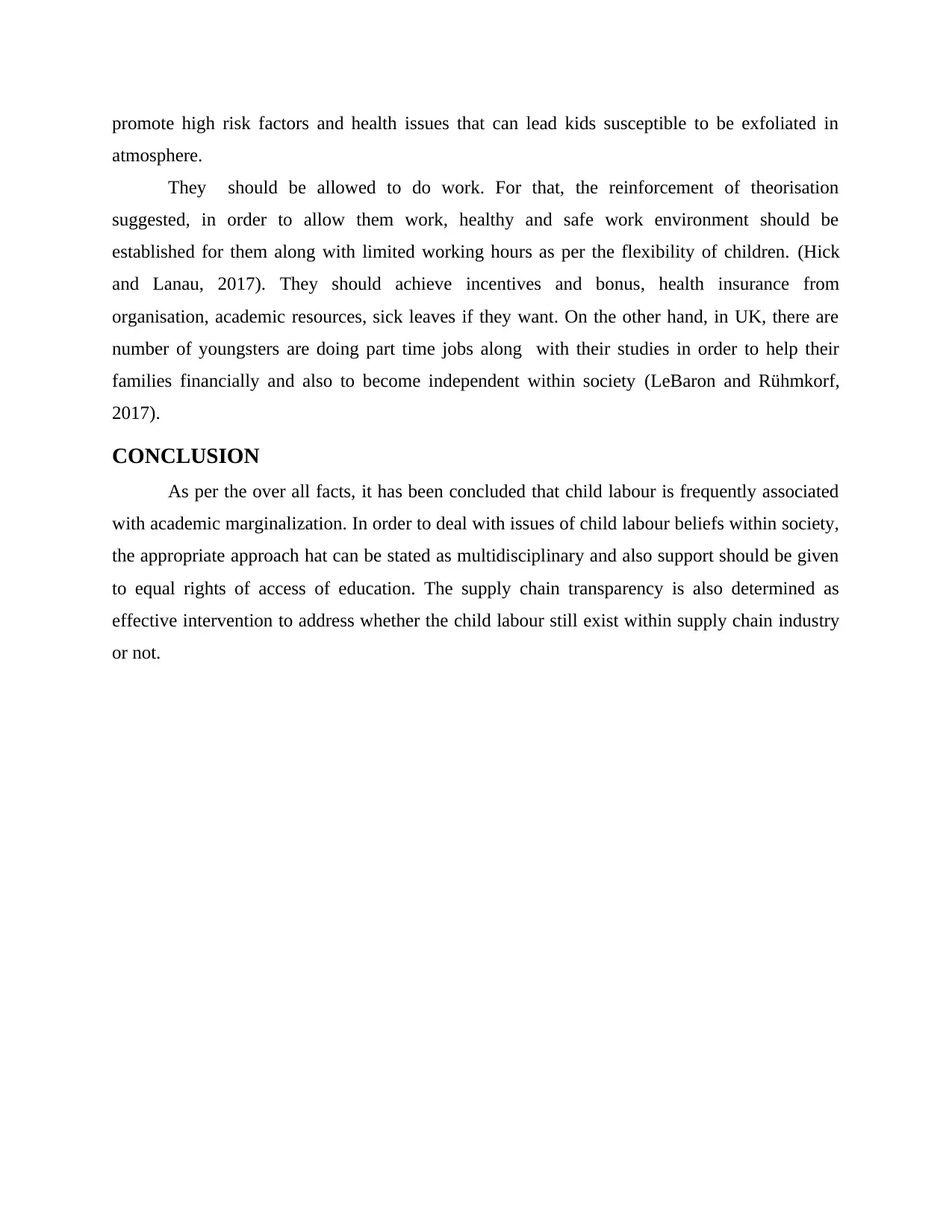
promote high risk factors and health issues that can lead kids susceptible to be exfoliated in
atmosphere.
They should be allowed to do work. For that, the reinforcement of theorisation
suggested, in order to allow them work, healthy and safe work environment should be
established for them along with limited working hours as per the flexibility of children. (Hick
and Lanau, 2017). They should achieve incentives and bonus, health insurance from
organisation, academic resources, sick leaves if they want. On the other hand, in UK, there are
number of youngsters are doing part time jobs along with their studies in order to help their
families financially and also to become independent within society (LeBaron and Rühmkorf,
2017).
CONCLUSION
As per the over all facts, it has been concluded that child labour is frequently associated
with academic marginalization. In order to deal with issues of child labour beliefs within society,
the appropriate approach hat can be stated as multidisciplinary and also support should be given
to equal rights of access of education. The supply chain transparency is also determined as
effective intervention to address whether the child labour still exist within supply chain industry
or not.
atmosphere.
They should be allowed to do work. For that, the reinforcement of theorisation
suggested, in order to allow them work, healthy and safe work environment should be
established for them along with limited working hours as per the flexibility of children. (Hick
and Lanau, 2017). They should achieve incentives and bonus, health insurance from
organisation, academic resources, sick leaves if they want. On the other hand, in UK, there are
number of youngsters are doing part time jobs along with their studies in order to help their
families financially and also to become independent within society (LeBaron and Rühmkorf,
2017).
CONCLUSION
As per the over all facts, it has been concluded that child labour is frequently associated
with academic marginalization. In order to deal with issues of child labour beliefs within society,
the appropriate approach hat can be stated as multidisciplinary and also support should be given
to equal rights of access of education. The supply chain transparency is also determined as
effective intervention to address whether the child labour still exist within supply chain industry
or not.
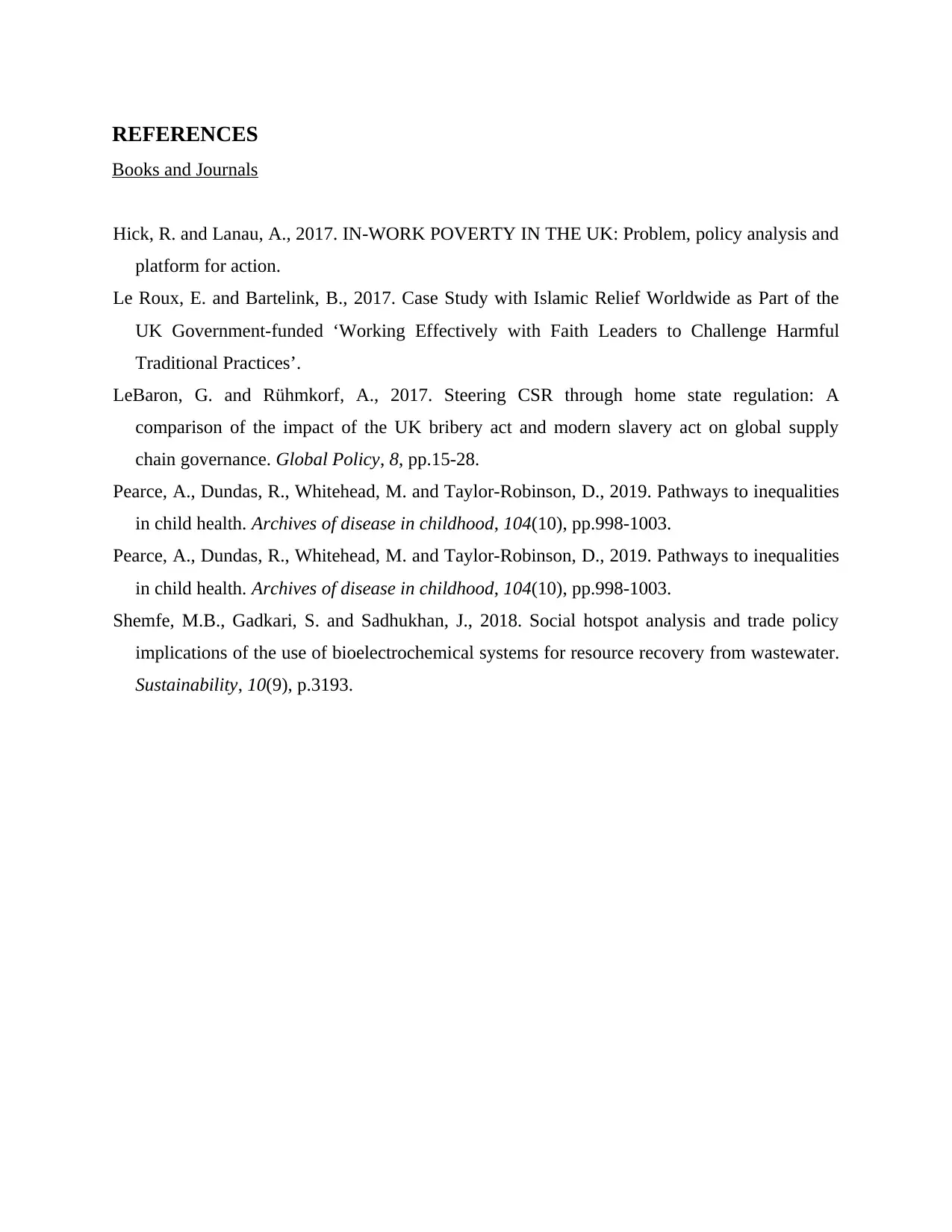
REFERENCES
Books and Journals
Hick, R. and Lanau, A., 2017. IN-WORK POVERTY IN THE UK: Problem, policy analysis and
platform for action.
Le Roux, E. and Bartelink, B., 2017. Case Study with Islamic Relief Worldwide as Part of the
UK Government-funded ‘Working Effectively with Faith Leaders to Challenge Harmful
Traditional Practices’.
LeBaron, G. and Rühmkorf, A., 2017. Steering CSR through home state regulation: A
comparison of the impact of the UK bribery act and modern slavery act on global supply
chain governance. Global Policy, 8, pp.15-28.
Pearce, A., Dundas, R., Whitehead, M. and Taylor-Robinson, D., 2019. Pathways to inequalities
in child health. Archives of disease in childhood, 104(10), pp.998-1003.
Pearce, A., Dundas, R., Whitehead, M. and Taylor-Robinson, D., 2019. Pathways to inequalities
in child health. Archives of disease in childhood, 104(10), pp.998-1003.
Shemfe, M.B., Gadkari, S. and Sadhukhan, J., 2018. Social hotspot analysis and trade policy
implications of the use of bioelectrochemical systems for resource recovery from wastewater.
Sustainability, 10(9), p.3193.
Books and Journals
Hick, R. and Lanau, A., 2017. IN-WORK POVERTY IN THE UK: Problem, policy analysis and
platform for action.
Le Roux, E. and Bartelink, B., 2017. Case Study with Islamic Relief Worldwide as Part of the
UK Government-funded ‘Working Effectively with Faith Leaders to Challenge Harmful
Traditional Practices’.
LeBaron, G. and Rühmkorf, A., 2017. Steering CSR through home state regulation: A
comparison of the impact of the UK bribery act and modern slavery act on global supply
chain governance. Global Policy, 8, pp.15-28.
Pearce, A., Dundas, R., Whitehead, M. and Taylor-Robinson, D., 2019. Pathways to inequalities
in child health. Archives of disease in childhood, 104(10), pp.998-1003.
Pearce, A., Dundas, R., Whitehead, M. and Taylor-Robinson, D., 2019. Pathways to inequalities
in child health. Archives of disease in childhood, 104(10), pp.998-1003.
Shemfe, M.B., Gadkari, S. and Sadhukhan, J., 2018. Social hotspot analysis and trade policy
implications of the use of bioelectrochemical systems for resource recovery from wastewater.
Sustainability, 10(9), p.3193.
⊘ This is a preview!⊘
Do you want full access?
Subscribe today to unlock all pages.

Trusted by 1+ million students worldwide
1 out of 6
Related Documents
Your All-in-One AI-Powered Toolkit for Academic Success.
+13062052269
info@desklib.com
Available 24*7 on WhatsApp / Email
![[object Object]](/_next/static/media/star-bottom.7253800d.svg)
Unlock your academic potential
Copyright © 2020–2025 A2Z Services. All Rights Reserved. Developed and managed by ZUCOL.




